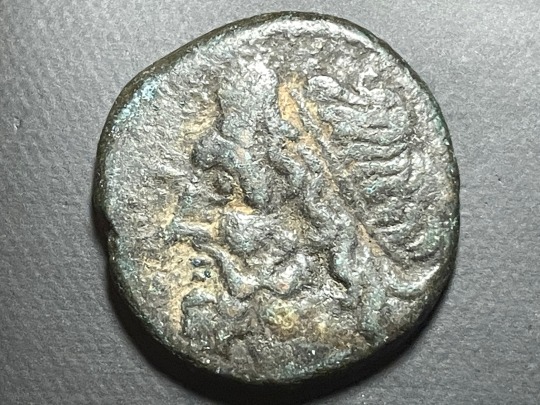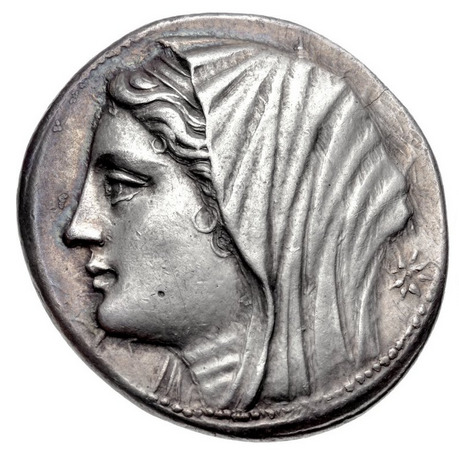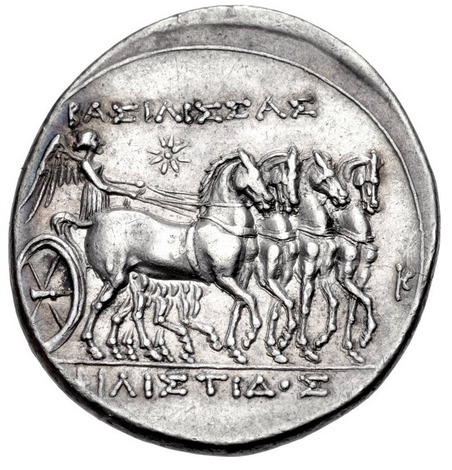#hieron ii
Explore tagged Tumblr posts
Photo


Beautiful Coin of Hieron II
This is a gold hemistater or drachm from Sicily, struck by Hieron circa 220-217 BC when he was king. The coin shows Persephone wreathed in barley with a cornucopia behind her. The reverse shows a charioteer driving a biga with prancing horses and an inscription IEPΩNOΣ below.
Hieron II was a tyrant and later became the king of Syracuse, Sicily (reigned circa 270-215 BC). He struggled against the Mamertini and eventually allied his city with Rome. He was the illegitimate son of a Syracusan noble, Hierocles, who claimed descent from Gelon. He was also a former general of Pyrrhus of Epirus and an important figure of the First Punic War.
On the departure of Pyrrhus, king of Epirus, from Sicily in 276 BC, the Syracusans appointed Hieron commander of the troops, and he strengthened his position by marrying the daughter of Leptines, the city’s leading citizen. Meanwhile, the Mamertini, a body of Campanian mercenaries who had been employed by Agathocles, the former tyrant of Syracuse, had captured the stronghold of Messana (Messina, in northeastern Sicily), from which they harassed the Syracusans. Hieron defeated them in a pitched battle near Mylae (Milazzo), but Carthaginian forces intervened to prevent him from capturing Messana. His grateful countrymen then chose Hieron as king. When in 264 BC he again attacked Messana, the Mamertini called on Rome for aid. Hieron at once joined the Carthaginian leader Hanno, who had recently landed in Sicily, but they were defeated by the Roman consul Appius Claudius Caudex, and Hieron withdrew to Syracuse.
Pressed by the Roman forces, in 263 BC he was compelled to conclude a treaty with Rome that restricted his kingdom to southeast Sicily and the eastern coast as far as Tauromenium (modern Taormina). From this date until his death he remained loyal to the Romans, frequently supplying them with soldiers and provisions during the Punic Wars. Hieron maintained a powerful defensive fleet and employed his famous kinsman, the Greek Archimedes, in the construction of ingenious mechanical devices for defense of the city. Hieron’s system of taxation was held up as a model of its kind and was used by the Romans in 241 BC, when they annexed Sicily as the first province.
#history#numismatics#coins#greek coins#hieron ii#hemistater#drachm#heiro ii#sicily#syracuse#persphone#cornucopia#biga#ancient coins#antiquities
344 notes
·
View notes
Text
Coin of the Day #172 (10/23/2024)
A very old Sicilian coin…


Sicily
AE19 - 5.52g
Hieron II 275-215 BC
Syracuse Mint
Obverse Head of Poseidon left, diademed
Reverse IEPΩNOΣ
Ornamented trident flanked by dolphins
#coin of the day#ancient greece#sicily#syracuse#hieron ii#greek coins#coin#coins#numismatics#ancient coins
4 notes
·
View notes
Photo


Tetradrachm of Philistis, wife of Hieron II, Syracuse, Sicily, struck c. 218/7-214 BC
The coin shows the diademed and veiled head of Philistis facing left with a star to her right. The reverse is inscribed with BAΣIΛIΣΣAΣ ΦIΛIΣTIΔOΣ (Basilissas Philistidos) and shows Nike, holding reins in both hands, driving a quadriga facing right; a star is above and a K to the right.
Philistis was a queen of ancient Syracuse, known only from her coins, which are numerous, and of fine workmanship, and from the occurrence of her name (bearing the title of queen, as it does also on her coins) in an inscription in large letters on the great theatre of Syracuse.
Hieron II was the Greek Sicilian king of Syracuse from 270 to 215 BC, and the illegitimate son of a Syracusan noble, Hierocles, who claimed descent from Gelon. He was a former general of Pyrrhus of Epirus and an important figure of the First Punic War. On the departure of Pyrrhus from Sicily (275 BC) the Syracusan army and citizens appointed him commander of the troops. He strengthened his position by marrying Philistis, the daughter of Leptines, the leading citizen.
#coins#philistis#hieron ii#syracuse#sicily#history#ancient#ancient coins#numismatics#tetradrachm#ancient history#greek coins#ancient greece#greek#greece#antiquities#art#treasure#3rd century bc#magna graecia#coin
215 notes
·
View notes